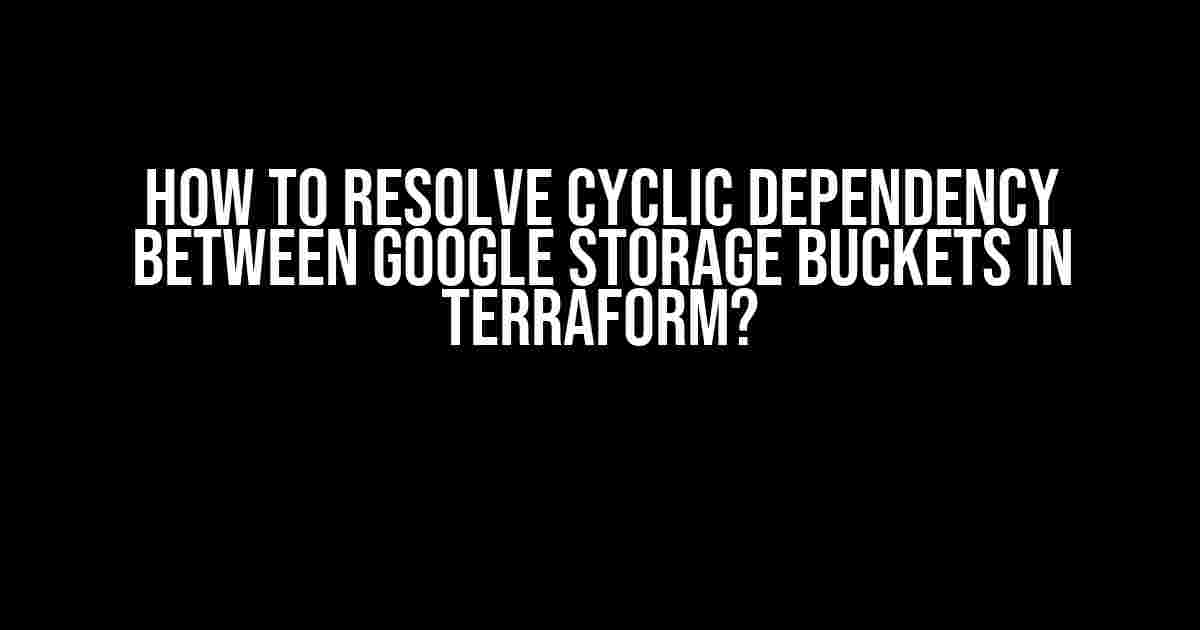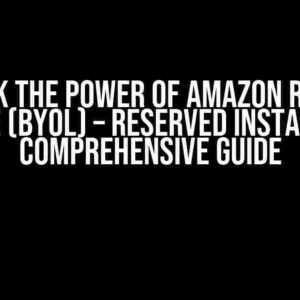If you’re reading this, chances are you’ve stumbled upon the infamous “Cyclic Dependency” error while trying to manage Google Storage Buckets using Terraform. Don’t worry, you’re not alone! In this article, we’ll dive into the world of Terraform and Google Storage Buckets, and provide a step-by-step guide on how to resolve this pesky issue.
What is a Cyclic Dependency?
Before we dive into the solution, let’s understand what a cyclic dependency is. In Terraform, a cyclic dependency occurs when two or more resources depend on each other, creating a loop where each resource needs the other to be created or updated. This can cause Terraform to throw an error, as it cannot determine the order of creation or update for these resources.
The Problem with Google Storage Buckets
In the context of Google Storage Buckets, a cyclic dependency can occur when you try to create a bucket that depends on another bucket, or when you have a bucket that depends on a resource (e.g., a service account) that, in turn, depends on the same bucket. This creates a chicken-and-egg problem, where Terraform doesn’t know which resource to create first.
Symptoms of a Cyclic Dependency
So, how do you know if you have a cyclic dependency? Look out for these symptoms:
- Error messages like “Error: Cycle detected in the dependencies of resource…” or “Error: Dependency cycle detected…”
- Terraform hangs or freezes during the apply or plan phase
- Terraform creates resources in an unexpected order, leading to errors or inconsistencies
Resolving Cyclic Dependencies in Terraform
Now that we’ve identified the problem, let’s get to the solution! There are a few ways to resolve cyclic dependencies in Terraform, and we’ll explore each of them below.
Method 1: Use Terraform’s built-in `depends_on` argument
Terraform provides a built-in `depends_on` argument that allows you to explicitly define dependencies between resources. By using this argument, you can tell Terraform to create resources in a specific order, avoiding cyclic dependencies.
resource "google_storage_bucket" "bucket1" {
name = "bucket1"
location = "US"
depends_on = [google_service_account.service_account]
}
resource "google_service_account" "service_account" {
account_id = "service-account"
}
In this example, `bucket1` depends on the `service_account` resource, ensuring that the service account is created before the bucket.
Method 2: Use Terraform’s `null_resource`
Another way to resolve cyclic dependencies is by using Terraform’s `null_resource`. A `null_resource` is a special type of resource that doesn’t create any infrastructure but can be used to create dependencies between resources.
resource "null_resource" "dependency" {
depends_on = [google_service_account.service_account]
}
resource "google_storage_bucket" "bucket1" {
name = "bucket1"
location = "US"
depends_on = [null_resource.dependency]
}
resource "google_service_account" "service_account" {
account_id = "service-account"
}
In this example, the `null_resource` is used to create a dependency between the `service_account` resource and the `bucket1` resource, ensuring that the service account is created before the bucket.
Method 3: Refactor your Terraform configuration
Sometimes, cyclic dependencies can be avoided by refactoring your Terraform configuration. Take a step back and re-evaluate your resource dependencies. Ask yourself:
- Do I really need to create these resources in a specific order?
- Can I create these resources independently of each other?
- Are there any resources that can be created in parallel?
By refactoring your Terraform configuration, you might be able to avoid cyclic dependencies altogether.
Best Practices for Avoiding Cyclic Dependencies
To avoid cyclic dependencies in the future, follow these best practices:
- Keep your resources modular: Divide your infrastructure into smaller, independent modules that can be managed separately.
- Use Terraform’s built-in dependencies: Leverage Terraform’s built-in `depends_on` argument to define explicit dependencies between resources.
- Avoid complex resource graphs: Try to keep your resource graph simple and flat, avoiding complex dependencies between resources.
- Test your Terraform configuration: Regularly test your Terraform configuration to catch cyclic dependencies early on.
Conclusion
Cyclic dependencies can be a real showstopper when working with Terraform and Google Storage Buckets. However, by understanding the causes of cyclic dependencies and using the methods outlined in this article, you can resolve these issues and get back to managing your infrastructure with confidence.
Remember to keep your resources modular, use Terraform’s built-in dependencies, avoid complex resource graphs, and test your Terraform configuration regularly. With these best practices in mind, you’ll be well on your way to avoiding cyclic dependencies and becoming a Terraform pro!
| Terraform Resource | Description |
|---|---|
| google_storage_bucket | Create a Google Storage Bucket |
| google_service_account | Create a Google Service Account |
| null_resource | Create a null resource to define dependencies between resources |
Additional Resources
Want to learn more about Terraform and Google Storage Buckets? Check out these additional resources:
- Terraform’s Built-in Dependencies
- Google Cloud Storage and Terraform
- Terraform Configuration Language
By following the guidelines and best practices outlined in this article, you’ll be well-equipped to resolve cyclic dependencies between Google Storage Buckets in Terraform and take your infrastructure management to the next level!
Frequently Asked Question
Get ready to untangle the knotty issue of cyclic dependencies between Google Storage Buckets in Terraform!
What is a cyclic dependency between Google Storage Buckets in Terraform, and why is it a problem?
A cyclic dependency occurs when two or more Google Storage Buckets depend on each other, either directly or indirectly, creating a loop that prevents Terraform from determining the correct order of creation or update operations. This is a problem because Terraform can’t resolve the dependencies, leading to errors and deployment failures. It’s like trying to solve a puzzle where the pieces don’t quite fit – frustrating, right?
How can I identify a cyclic dependency between Google Storage Buckets in Terraform?
To identify a cyclic dependency, review your Terraform configuration files and look for any interdependent resources, such as buckets and objects. Check for anyUCKET references in your code, especially in the `depends_on` or `lifecycle` blocks. If you spot any circular references, you’ve got a cyclic dependency on your hands! You can also use Terraform’s built-in tools, like the `terraform graph` command, to visualize your infrastructure and spot potential cycles.
Can I use Terraform’s `depends_on` argument to resolve cyclic dependencies between Google Storage Buckets?
Nope! The `depends_on` argument won’t help you resolve cyclic dependencies. In fact, using `depends_on` can sometimes create or exacerbate cyclic dependencies. Instead, focus on redesigning your infrastructure to avoid these cycles altogether. You can do this by breaking down your resources into smaller, independent modules or by using Terraform’s `null_resource` to create placeholder resources that can be used to satisfy dependencies.
How can I redesign my infrastructure to avoid cyclic dependencies between Google Storage Buckets in Terraform?
To avoid cyclic dependencies, try to design your infrastructure as a hierarchical, acyclic graph. Break down your resources into smaller, independent modules, and use Terraform’s module system to manage dependencies between them. For example, you can create separate modules for data processing, storage, and analytics, each with its own set of resources and dependencies. This will help you avoid cyclic dependencies and make your infrastructure more modular, scalable, and maintainable.
What are some best practices for managing dependencies between Google Storage Buckets in Terraform?
To manage dependencies between Google Storage Buckets effectively, follow these best practices: keep your resources organized, use meaningful names and labels, and avoid complex dependencies. Also, use Terraform’s built-in features, like the `lifecycle` block, to manage resource creation and deletion orders. Finally, test and validate your infrastructure regularly to ensure it’s free from cyclic dependencies and other issues. By following these best practices, you’ll be well on your way to taming the beast of cyclic dependencies!



